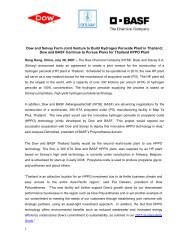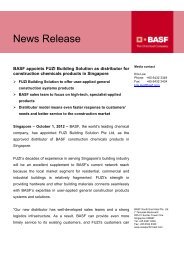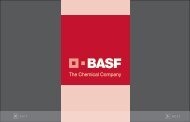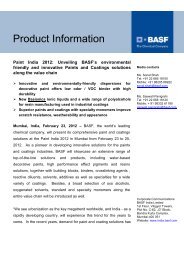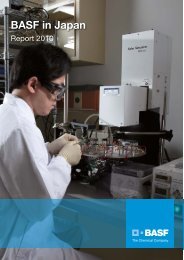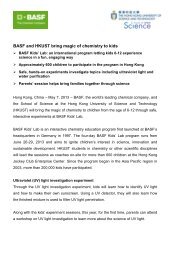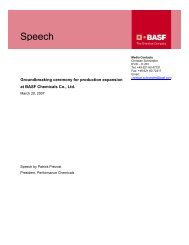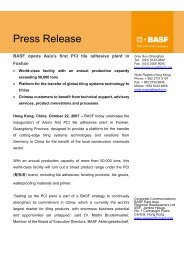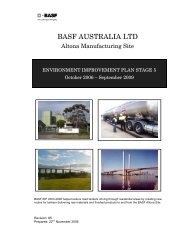Ammonium sulphate nitrate - BASF Asia Pacific
Ammonium sulphate nitrate - BASF Asia Pacific
Ammonium sulphate nitrate - BASF Asia Pacific
Create successful ePaper yourself
Turn your PDF publications into a flip-book with our unique Google optimized e-Paper software.
Three reason’s<br />
to have confidence<br />
in <strong>BASF</strong>...<br />
<strong>BASF</strong> Australia proudly acknowledge their partnership<br />
with these internationally renowned companies. Manufacturers<br />
of quality products for the Australian agricultural market.
Contents<br />
Broadacre<br />
Horticulture<br />
Turf<br />
Nursery<br />
Home Garden<br />
Entec Next Generation Fertilisers N P K Mg S TE<br />
Field Grade<br />
These products have been treated to inhibit ENTEC® blue special 12 5 14 1 6 ✔<br />
nitrification for a period of time. ENTEC® perfekt 14 3 14 1 11 ✔<br />
These products have application for users striving ENTEC® 26 26 13<br />
for quality and/or yield gains in conventional and ENTEC® N-Mag 22 4 12<br />
environmentally sensitive areas.<br />
Fertigation Grade<br />
ENTEC® solub 21 21 24<br />
ENTEC® solub 14-21 14 21 5<br />
ENTEC® solub 20-2.2-8.3 20 2 8 1 13<br />
ENTEC® solub 16-4.4-14.1 16 4 14 11<br />
ENTEC® solub 14-3.5-24.9 14 4 25 6<br />
Compound Fertilisers N P K Mg S TE<br />
Each granule of these products contains Nitrophoska® blue special 12 5 14 1 6 ✔<br />
the same amount of nutrient. This allows for Nitrophoska® elite 12 4 17 1 8 ✔<br />
uniform and efficient plant uptake. Nitrophoska® perfekt 15 2 17 1 8 ✔<br />
Nitrophoska® suprem 20 2 8 1.8 3 ✔<br />
Field Grade Fertilisers N P K Mg S TE<br />
Fine particle size enables use on turf to Ferro Top 6 10 4 18 ✔<br />
improve nutrient levels. Kali Gazon 22 7 17<br />
Use of these products allows the flexible <strong>Ammonium</strong> <strong>sulphate</strong> <strong>nitrate</strong> 26 14<br />
application of efficient, immediately plant<br />
<strong>Ammonium</strong> <strong>sulphate</strong> <strong>nitrate</strong><br />
useable Nitrogen sources, in the form of with boron 26 13 ✔<br />
ammonium and <strong>nitrate</strong>.<br />
<strong>Ammonium</strong> <strong>sulphate</strong> <strong>nitrate</strong><br />
with magnesium 22 4 12<br />
Calcium ammonium <strong>nitrate</strong> 29 (Ca = 9)<br />
Magnesium and Potassium products with ESTA® Kieserite Fine 16 22<br />
readily plant available nutrients which can be ESTA® Kieserite Granular 15 20<br />
field applied. Korn-Kali Granular 33 4 4<br />
Patent Kali Granular 25 6 17<br />
Patent pk 5 13 3<br />
Muriate of Potash Granular 50<br />
Sulphate of Potash Granular 42 8
Broadacre<br />
Horticulture<br />
Turf<br />
Nursery<br />
Home Garden<br />
Controlled Release Fertilisers N P K Mg S TE<br />
The controlled even release of nutrient for Basacote® Plus 3M 16 4 10 1 5 ✔<br />
these products is controlled by the products Basacote® Plus 6M 16 4 10 1 5 ✔<br />
polymer coating. Basacote® Tabs 6M 16 4 10 1 5 ✔<br />
Basacote® Plus 6MK 11 4 16 1 7 ✔<br />
Basacote® Tabs 6MK 11 4 16 1 7 ✔<br />
Basacote® Plus 9M 16 4 10 1 5 ✔<br />
Basacote® Plus 9MK 11 4 16 1 7 ✔<br />
Basacote® Plus 12M 15 4 10 1 5 ✔<br />
The slow release of nutrients for these products is Floranid® Club 10 2 17 2 8 ✔<br />
controlled by the Isodur Ntrogen content. Floranid® Eagle 24 2 8 ✔<br />
Floranid® Eagle K 12 3 20 ✔<br />
Floranid® Eagle NK 20 17 2 3 ✔<br />
Floranid® Eagle Start 18 11 4 ✔<br />
Floranid® Master 16 2 8 3 8 ✔<br />
Floranid® Master Extra 19 2 8 1 8 ✔<br />
Floranid® N32% 32<br />
Floranid® NK 14 16 2 10<br />
Floranid® Turf 20 2 7 1 7 ✔<br />
Nitrophoska® Slow Release 15 4 13 1 8 ✔<br />
The ploymer coating on part of these products Nitrophoska® Top 15 15 4 13 1 6 ✔<br />
enables these products to exhibit both controlled Nitrophoska® Top 20 20 2 8 2 5 ✔<br />
and quick acting release characteristics. Nutriforest 9 10 12 2 7 ✔<br />
The slow release of nutrient for this product is Triabon® 16 4 10 2 9 ✔<br />
controlled by the Crotodur Nitrogen content.<br />
Soil Conditioners N P K Mg S TE<br />
Improves soil conditions to aid in root growth Agrosil LR 9<br />
Wetting agent concentrate<br />
KICK<br />
Organic Fertilisers N P K Mg S TE<br />
Products certified by the Biological Farmers of Epsom Salt Pure, Technical 16 20<br />
Australia Co-op Ltd for use on Organic Farms ESTA® Kieserite Fine 16 22<br />
ESTA® Kieserite Granular 15 20<br />
Patent Kali Granular 25 6 17<br />
Patent pk 5 13 3<br />
Sulphate of Potash Granular 42 18
Broadacre<br />
Horticulture<br />
Turf<br />
Nursery<br />
Home Garden<br />
Foliar & Soluble Fertilisers N P K Mg S Ca TE<br />
Fertigation Grade<br />
These products can be used for Fertigation to ENTEC® solub 21 21 24<br />
supply plants with necessary nutrients. ENTEC® solub 14- 21 14 21 5<br />
ENTEC® solub 20-2.2-8.3 20 2 8 1 13<br />
ENTEC® solub 16-4.4-14.1 16 4 14 11.2<br />
ENTEC® solub 14-3.5-24.9 14 4 25 6<br />
Monoammonium Phosphate<br />
(MAP), Greenhouse Grade 12 27<br />
Monopotassium Phosphate (MKP) 23 29<br />
Muriate of Potash Fine 50<br />
Nitrophoska® solub 14-2.6-19.9 14 3 20 2 7 ✔<br />
Nitrophoska® solub 15-4.4-12.5 15 4 13 1 12 ✔<br />
Nitrophoska® solub 8-5.2-19.9 8 5 20 2 12 ✔<br />
Basafer (Iron = 6) ✔<br />
Used for Fertigation and or Foliar application<br />
Other Products<br />
Calcium Nitrate,<br />
Greenhouse Grade 15 20<br />
Epsom Salt Pure, Technical 16 20<br />
Foliar Nitrophoska® 12 2 7 1 ✔<br />
Potassium Nitrate 13 38<br />
SoluPotasse® Sulphate of Potash 42 18<br />
Trace Elements<br />
Range of nutrients to be applied as foliar Basfoliar Combi-Stipp 9 11 ✔<br />
or fertigation applications based on various Basfoliar 36 extra 27 2 ✔<br />
technologies. Basfoliar range (various nutrients) ✔<br />
Fetrilon® 13% (Iron = 13) ✔<br />
Fetrilon® Combi-2<br />
Zitrilon SM 10% (Zinc = 10) ✔<br />
✔<br />
Articles
Field Grade Fertilisers<br />
Field Grade Fertilisers
Field Grade Fertilisers<br />
Field Grade Fertilisers<br />
Ferro Top<br />
TECHNICAL DATA<br />
Primary Nutrients:<br />
6.0% Nitrogen (N)<br />
3.7% NH 4 Nitrogen<br />
2.3% NH 2 Nitrogen<br />
10.0% Potassium (K), water soluble<br />
Secondary Nutrients:<br />
3.6% Magnesium (Mg)<br />
18.0% Sulphur (S)<br />
8.0% Iron (Fe)<br />
0.01% Manganese (Mn)<br />
Physical properties:<br />
Finely granulated fertiliser<br />
Granulometry:<br />
Min 90% 0.5-2.0 mm<br />
Bulk Density:<br />
Approx. 920 kg/m 3<br />
Recommendations for application:<br />
The fine and even granulation of Ferro Top allows it to be easily applied with spreaders or by hand.<br />
The application of Ferro Top allows for even nutrient distribution, as every granule contains the same<br />
macro and micro-nutrients.<br />
Application of Ferro Top is possible during the whole vegetation period, but particularly<br />
recommended to promote turf health for periods of upcoming stress such as frost, heat or fungal<br />
disease.<br />
Watering-in (minimum 5 mm) after application is strongly recommended.<br />
The amount of Ferro Top applied will vary according to location of the turf, soil nutrient reserves and<br />
seasonal influences such as wet conditions but the below rates are given as a guide. These<br />
recommendations are given as a practical guide to good agronomic practice under most situations.<br />
Local agronomic conditions should also be taken into account, as these may affect responsiveness<br />
of fertiliser application.<br />
Area kg/100m 2 g/m 2 Applications per year<br />
Golf greens 2 - 4 20 - 40 2 - 4<br />
Golf tees 2 - 4 20 - 40 2 - 4<br />
Golf fairways 2.5 - 3.5 25 - 35 2 - 3<br />
Sportfields/ 3 - 4 30 - 40 1 - 2<br />
Ornamental turf<br />
Colour:<br />
Red brown<br />
Storage Notes:<br />
Ferro Top may absorb moisture if exposed to the atmosphere. Store in a dry place ensuring bags are<br />
closed completely<br />
A 25kg bag of Ferro Top contains<br />
1.5 kg Nitrogen (N)<br />
2.5 kg Potassium (K)<br />
0.9 kg Magnesium (Mg)<br />
2.0 kg Iron (Fe)<br />
Important Information:<br />
Careful tests have proven that the product is suitable for the recommended purposes when used in accordance with our instructions and is correct<br />
at time of printing. However, since storage, use and external factors are beyond our control and we are unable to foresee all circumstances arising<br />
there from, we are only liable for a consistent quality of the product, but the risk of its storage and use and external factors and all consequential<br />
loss and damage arising therefrom are not the responsibility of <strong>BASF</strong>. Always check label before use and heed label instructions.<br />
Important Information:<br />
Careful tests have proven that the product is suitable for the recommended purposes when used in accordance with our instructions and is correct<br />
at time of printing. However, since storage, use and external factors are beyond our control and we are unable to foresee all circumstances arising<br />
there from, we are only liable for a consistent quality of the product, but the risk of its storage and use and external factors and all consequential<br />
loss and damage arising therefrom are not the responsibility of <strong>BASF</strong>. Always check label before use and heed label instructions.
Field Grade Fertilisers<br />
Field Grade Fertilisers<br />
Kali Gazon<br />
TECHNICAL DATA<br />
Primary nutrients:<br />
22.4% Potassium (K) as potassium <strong>sulphate</strong>, water soluble<br />
Secondary nutrients:<br />
6.6% Magnesium (Mg) water soluble<br />
17.0% Sulphur (S) water soluble<br />
Physical Properties:<br />
Finely granulated fertiliser<br />
Granulometry:<br />
Min 90% 0.5 - 2.0 mm<br />
Bulk Density:<br />
Approx. 1130 kg/m 3<br />
Colour:<br />
Grey<br />
Recommendations for application<br />
Kali Gazon is designed to supply potassium and magnesium to fine and low cut turf, especially on<br />
sandy root zone mixtures with low Cation Exchange Capacity. The fine and even granulation of Kali<br />
Gazon allows it to be easily applied with spreaders. The application of Kali Gazon allows for even<br />
nutrient distribution, as every granule contains the same nutrients.<br />
Application of Kali Gazon is possible during the whole vegetation period, but particularly<br />
recommended to promote turf health for periods of upcoming stress such as frost, heat or fungal<br />
disease.<br />
Watering-in after application is recommended to achieve the immediate effect<br />
The amount of Kali Gazon applied will vary according to location of the turf, soil nutrient reserves and<br />
seasonal influences such as wet conditions but the below rates are given as a guide. These<br />
recommendations are given as a practical guide to good agronomic practice under most situations.<br />
Local agronomic conditions should also be taken into account, as these may affect responsiveness<br />
of fertiliser application.<br />
Area kg/100m 2 g/m 2 Applications per year<br />
Golf Greens 2.5 - 3.5 25 - 35 2 - 4<br />
Golf Tees 2.5 - 4.0 25 - 40 2 - 3<br />
Golf Fairways 3.0 - 4.0 30 - 40 1 - 2<br />
Sportfields/ 3.0 - 4.0 30 - 40 1 - 2<br />
Ornamental turf<br />
Storage Notes:<br />
Kali Gazon may absorb moisture if exposed to the atmosphere. Store in a dry place ensuring bags<br />
are closed completely<br />
A 25 kg bag of Kali Gazon contains<br />
5.6 kg Potassium (K)<br />
1.7 kg Magnesium (Mg)<br />
Important Information:<br />
Careful tests have proven that the product is suitable for the recommended purposes when used in accordance with our instructions and is correct<br />
at time of printing. However, since storage, use and external factors are beyond our control and we are unable to foresee all circumstances arising<br />
there from, we are only liable for a consistent quality of the product, but the risk of its storage and use and external factors and all consequential<br />
loss and damage arising therefrom are not the responsibility of <strong>BASF</strong>. Always check label before use and heed label instructions.<br />
Important Information:<br />
Careful tests have proven that the product is suitable for the recommended purposes when used in accordance with our instructions and is correct<br />
at time of printing. However, since storage, use and external factors are beyond our control and we are unable to foresee all circumstances arising<br />
there from, we are only liable for a consistent quality of the product, but the risk of its storage and use and external factors and all consequential<br />
loss and damage arising therefrom are not the responsibility of <strong>BASF</strong>. Always check label before use and heed label instructions.
Field Grade Fertilisers<br />
Field Grade Fertilisers<br />
<strong>Ammonium</strong> <strong>sulphate</strong> <strong>nitrate</strong><br />
TECHNICAL DATA<br />
Primary nutrients:<br />
26.0% Nitrogen (N)<br />
19.0% NH 4 Nitrogen<br />
7.0% NO 3 Nitrogen<br />
Secondary nutrients:<br />
14.0% Sulphur (S)<br />
Physical properties:<br />
Granular solid fertiliser; surface-treated for improved transport and storage properties.<br />
Granulometry:<br />
Mean 3.0 - 3.6 mm<br />
Min. 85% 2.0 - 5.0 mm<br />
Bulk Density:<br />
Approx. 0.95 t/m 3<br />
Physiological Acidity:<br />
On account of its Sulphur content <strong>Ammonium</strong> <strong>sulphate</strong> <strong>nitrate</strong> has a relatively strong physiological<br />
acidity. The theoretical effect of 100 kg <strong>Ammonium</strong> <strong>sulphate</strong> <strong>nitrate</strong> on arable land is about - 89 kg<br />
Lime according to Sluijsmans’ formula.<br />
A 50 kg bag of Ammnonium <strong>sulphate</strong> <strong>nitrate</strong> contains<br />
13.0 kg Nitrogen (N)<br />
7.0 kg Sulphur (S)<br />
Recommendations for application<br />
<strong>Ammonium</strong> <strong>sulphate</strong> <strong>nitrate</strong> is particular suitable for:<br />
• basal supply of crops with nitrogen and sulphur<br />
• top dressings with nitrogen and sulphur<br />
• use on alkaline soils with a high pH levels<br />
• use at sulphur deficient locations<br />
• acid-loving crops<br />
<strong>Ammonium</strong> <strong>sulphate</strong> <strong>nitrate</strong> contains both the ammonium and <strong>nitrate</strong> forms of nitrogen, thus<br />
providing a rapid onset of action and sustained action of the nitrogen. The use of this fertiliser also<br />
ensures an optimum supply of sulphur. When <strong>Ammonium</strong> <strong>sulphate</strong> <strong>nitrate</strong> is used on soils with a<br />
tendency to soil acidification, the pH must be controlled and maintained by appropriate liming.<br />
Oilseeds<br />
Canola removes up to 7 times as much sulphur and twice as much nitrogen from the soil to produce<br />
one tonne of grain, compared with cereal crops.<br />
<strong>Ammonium</strong> <strong>sulphate</strong> <strong>nitrate</strong> contains sulphur in the form of <strong>sulphate</strong>, which is readily useable by<br />
plants, particularly those such as Canola.<br />
Sulphur should be applied either at sowing or at an early stage of growth with rates of <strong>Ammonium</strong><br />
<strong>sulphate</strong> <strong>nitrate</strong> varying from 100-200 kg/ha. Good recovery from low sulphur levels has been<br />
achieved by top-dressing with rates of 50-150 kg/ha.<br />
Cereals<br />
Early Season: Ideal cool season nitrogen fertiliser, as <strong>Ammonium</strong> <strong>sulphate</strong> <strong>nitrate</strong> has 7%<br />
immediately available Nitrate-N for early season growth.<br />
The synergistic effect of mixed nitrogen nutrition (Nitrate-N plus <strong>Ammonium</strong>-N) has proven to<br />
increase early plant growth and tiller production in cereals compared to either from of nitrogen alone.<br />
At drilling and/or early tiller development apply 50-150 kg/ha of <strong>Ammonium</strong> <strong>sulphate</strong> <strong>nitrate</strong><br />
(40-50 kg N/ha).<br />
Mid Season: Apply <strong>Ammonium</strong> <strong>sulphate</strong> <strong>nitrate</strong> to optimize milling quality through higher grain<br />
protein and improved dough development. <strong>Ammonium</strong> <strong>sulphate</strong> <strong>nitrate</strong> N:S ratio of 2:1 provides a<br />
good balance of nitrogen and sulphur.<br />
During stem elongation apply 50-150 kg/ha of <strong>Ammonium</strong> <strong>sulphate</strong> <strong>nitrate</strong> (40-50 kg N/ha).<br />
Pasture<br />
With Nitrate-N immediately available, pasture production is improved during the cooler autumn and<br />
spring periods.<br />
<strong>Ammonium</strong> <strong>sulphate</strong> <strong>nitrate</strong> is suited for pastures at drilling, also as a nitrogen/sulphur fertiliser for<br />
hay and silage.<br />
At drilling: Apply 50-100 kg/ha <strong>Ammonium</strong> <strong>sulphate</strong> <strong>nitrate</strong> (25-30 kg N/ha) .<br />
For spreading: Apply 50-150 kg/ha <strong>Ammonium</strong> <strong>sulphate</strong> <strong>nitrate</strong> (50-65 kg N/ha).<br />
Important Information:<br />
Careful tests have proven that the product is suitable for the recommended purposes when used in accordance with our instructions and is correct<br />
at time of printing. However, since storage, use and external factors are beyond our control and we are unable to foresee all circumstances arising<br />
there from, we are only liable for a consistent quality of the product, but the risk of its storage and use and external factors and all consequential<br />
loss and damage arising therefrom are not the responsibility of <strong>BASF</strong>. Always check label before use and heed label instructions.<br />
Important Information:<br />
Careful tests have proven that the product is suitable for the recommended purposes when used in accordance with our instructions and is correct<br />
at time of printing. However, since storage, use and external factors are beyond our control and we are unable to foresee all circumstances arising<br />
there from, we are only liable for a consistent quality of the product, but the risk of its storage and use and external factors and all consequential<br />
loss and damage arising therefrom are not the responsibility of <strong>BASF</strong>. Always check label before use and heed label instructions.
Field Grade Fertilisers<br />
Field Grade Fertilisers<br />
<strong>Ammonium</strong> <strong>sulphate</strong> <strong>nitrate</strong><br />
with boron<br />
TECHNICAL DATA<br />
Primary nutrients:<br />
26.0% Nitrogen (N)<br />
18.5% NH 4 Nitrogen<br />
7.5% NO 3 Nitrogen<br />
Secondary nutrients:<br />
13.0% Sulphur (S)<br />
0.3% Boron (B)<br />
Physical properties:<br />
Granular solid fertiliser; surface-treated for improved transport and storage properties.<br />
Granulometry:<br />
Mean 3.0 - 3.6 mm<br />
Min. 90% 2.0 - 5.0 mm<br />
Bulk Density:<br />
Approx. 1.0 t/m 3<br />
A 50 kg bag of Ammnonium <strong>sulphate</strong> <strong>nitrate</strong> with boron contains<br />
13.0 kg Nitrogen (N)<br />
7.0 kg Sulphur (S)<br />
0.2 kg Boron (B)<br />
Recommendations for application<br />
<strong>Ammonium</strong> <strong>sulphate</strong> <strong>nitrate</strong> with boron is particular suitable for:<br />
• basal supply of crops with nitrogen, sulphur and boron<br />
• top dressings with nitrogen, sulphur and boron<br />
• use on alkaline soils with a high pH levels<br />
• use at sulphur and boron deficient locations<br />
• acid-loving crops<br />
<strong>Ammonium</strong> <strong>sulphate</strong> <strong>nitrate</strong> with boron contains both the ammonium and <strong>nitrate</strong> forms of nitrogen,<br />
thus providing a rapid onset of action and sustained action of the nitrogen. The use of this fertiliser<br />
also ensures a supply of sulphur and boron. When <strong>Ammonium</strong> <strong>sulphate</strong> <strong>nitrate</strong> with boron is used on<br />
soils with a tendency to soil acidification, the pH must be controlled and maintained by appropriate<br />
liming.<br />
Oilseeds<br />
Canola removes up to 7 times as much sulphur and twice as much nitrogen from the soil to produce<br />
one tonne of grain, compared with cereal crops.<br />
<strong>Ammonium</strong> <strong>sulphate</strong> <strong>nitrate</strong> with boron contains sulphur in the form of <strong>sulphate</strong>, which is readily<br />
useable by plants, particularly those such as Canola.<br />
Sulphur should be applied either at sowing or at an early stage of growth with rates of <strong>Ammonium</strong><br />
<strong>sulphate</strong> <strong>nitrate</strong> with boron varying from 100-200 kg/ha. Good recovery from low sulphur levels has<br />
been achieved by top-dressing with rates of 50-150 kg/ha.<br />
Cereals<br />
Early Season: Ideal cool season nitrogen fertiliser, as <strong>Ammonium</strong> <strong>sulphate</strong> <strong>nitrate</strong> with boron has<br />
7.5% immediately available Nitrate-N for early season growth.<br />
The synergistic effect of mixed nitrogen nutrition (Nitrate-N plus <strong>Ammonium</strong>-N) has proven to<br />
increase early plant growth and tiller production in cereals compared to either from of nitrogen alone.<br />
At drilling and/or early tiller development apply 50-150 kg/ha of <strong>Ammonium</strong> <strong>sulphate</strong> <strong>nitrate</strong> with<br />
boron (40-50 kg N/ha).<br />
Mid Season: Apply <strong>Ammonium</strong> <strong>sulphate</strong> <strong>nitrate</strong> with boron to optimize milling quality through higher<br />
grain protein and improved dough development. <strong>Ammonium</strong> <strong>sulphate</strong> <strong>nitrate</strong> with boron N:S ratio of<br />
2:1 provides a good balance of nitrogen and sulphur.<br />
During stem elongation apply 50-150 kg/ha of <strong>Ammonium</strong> <strong>sulphate</strong> <strong>nitrate</strong> with boron (40-50 kg N/ha).<br />
Pasture<br />
With Nitrate-N immediately available, pasture production is improved during the cooler autumn and<br />
spring periods.<br />
<strong>Ammonium</strong> <strong>sulphate</strong> <strong>nitrate</strong> with boron is suited for pastures at drilling, also as a nitrogen/sulphur<br />
fertiliser for hay and silage.<br />
At drilling: Apply 50-100 kg/ha <strong>Ammonium</strong> <strong>sulphate</strong> <strong>nitrate</strong> with boron (25-30 kg N/ha) .<br />
For spreading: Apply 50-150 kg/ha <strong>Ammonium</strong> <strong>sulphate</strong> <strong>nitrate</strong> with boron (50-65 kg N/ha).<br />
Important Information:<br />
Careful tests have proven that the product is suitable for the recommended purposes when used in accordance with our instructions and is correct<br />
at time of printing. However, since storage, use and external factors are beyond our control and we are unable to foresee all circumstances arising<br />
there from, we are only liable for a consistent quality of the product, but the risk of its storage and use and external factors and all consequential<br />
loss and damage arising therefrom are not the responsibility of <strong>BASF</strong>. Always check label before use and heed label instructions.<br />
Important Information:<br />
Careful tests have proven that the product is suitable for the recommended purposes when used in accordance with our instructions and is correct<br />
at time of printing. However, since storage, use and external factors are beyond our control and we are unable to foresee all circumstances arising<br />
there from, we are only liable for a consistent quality of the product, but the risk of its storage and use and external factors and all consequential<br />
loss and damage arising therefrom are not the responsibility of <strong>BASF</strong>. Always check label before use and heed label instructions.
Field Grade Fertilisers<br />
Field Grade Fertilisers<br />
<strong>Ammonium</strong> <strong>sulphate</strong> <strong>nitrate</strong><br />
with magnesium<br />
TECHNICAL DATA<br />
Primary nutrients:<br />
22.0% Nitrogen (N)<br />
15.0% NH 4 Nitrogen<br />
7.0% NO 3 Nitrogen<br />
Secondary nutrients:<br />
12.0% Sulphur (S)<br />
3.6% Magnesium (Mg)<br />
Physical properties:<br />
Granular solid fertiliser; surface-treated for improved transport and storage properties.<br />
Granulometry:<br />
Mean 3.0 - 3.6 mm<br />
Min. 90% 2.0 - 5.0 mm<br />
Bulk Density:<br />
Approx. 1.0 t/m 3<br />
A 50 kg bag of Ammnonium <strong>sulphate</strong> <strong>nitrate</strong> with magnesium contains<br />
13.0 kg Nitrogen (N)<br />
7.0 kg Sulphur (S)<br />
1.8 kg Magnesium (Mg)<br />
Recommendations for application<br />
<strong>Ammonium</strong> <strong>sulphate</strong> <strong>nitrate</strong> with magnesium is particular suitable for:<br />
• basal supply of crops with nitrogen, sulphur and magnesium<br />
• top dressings with nitrogen, sulphur and magnesium<br />
• use on alkaline soils with a high pH levels<br />
• use at sulphur and magnesium deficient locations<br />
• acid-loving crops<br />
<strong>Ammonium</strong> <strong>sulphate</strong> <strong>nitrate</strong> with magnesium contains both the ammonium and <strong>nitrate</strong> forms of<br />
nitrogen, thus providing a rapid onset of action and sustained action of the nitrogen. The use of this<br />
fertiliser also ensures an adequate supply of sulphur and magnesium. When <strong>Ammonium</strong> <strong>sulphate</strong><br />
<strong>nitrate</strong> with magnesium is used on soils with a tendency to soil acidification, the pH must be<br />
controlled and maintained by appropriate liming.<br />
Oilseeds<br />
Canola removes up to 7 times as much sulphur and twice as much nitrogen from the soil to produce<br />
one tonne of grain, compared with cereal crops.<br />
<strong>Ammonium</strong> <strong>sulphate</strong> <strong>nitrate</strong> with magnesium contains sulphur in the form of <strong>sulphate</strong>, which is<br />
readily useable by plants, particularly those such as Canola.<br />
Sulphur should be applied either at sowing or at an early stage of growth with rates of <strong>Ammonium</strong><br />
<strong>sulphate</strong> <strong>nitrate</strong> with magnesium varying from 100-200 kg/ha. Good recovery from low sulphur levels<br />
has been achieved by top-dressing with rates of 50-150 kg/ha.<br />
Cereals<br />
Early Season: Ideal cool season nitrogen fertiliser, as <strong>Ammonium</strong> <strong>sulphate</strong> <strong>nitrate</strong> with magnesium<br />
has 7% immediately available Nitrate-N for early season growth.<br />
The synergistic effect of mixed nitrogen nutrition (Nitrate-N plus <strong>Ammonium</strong>-N) has proven to<br />
increase early plant growth and tiller production in cereals compared to either from of nitrogen alone.<br />
At drilling and/or early tiller development apply 50-150 kg/ha of <strong>Ammonium</strong> <strong>sulphate</strong> <strong>nitrate</strong> with<br />
magnesium (40-50 kg N/ha).<br />
Mid Season: Apply <strong>Ammonium</strong> <strong>sulphate</strong> <strong>nitrate</strong> with magnesium to optimize milling quality through<br />
higher grain protein and improved dough development. <strong>Ammonium</strong> <strong>sulphate</strong> <strong>nitrate</strong> with magnesium<br />
N:S ratio of 2:1 provides a good balance of nitrogen and sulphur.<br />
During stem elongation apply 50-150 kg/ha of <strong>Ammonium</strong> <strong>sulphate</strong> <strong>nitrate</strong> with magnesium (40-50<br />
kg N/ha).<br />
Pasture<br />
With Nitrate-N immediately available, pasture production is improved during the cooler autumn and<br />
spring periods.<br />
<strong>Ammonium</strong> <strong>sulphate</strong> <strong>nitrate</strong> with magnesium is suited for pastures at drilling, also as a<br />
nitrogen/sulphur fertiliser for hay and silage.<br />
At drilling: Apply 50-100 kg/ha <strong>Ammonium</strong> <strong>sulphate</strong> <strong>nitrate</strong> with magnesium (25-30 kg N/ha)<br />
For spreading: Apply 50-150 kg/ha <strong>Ammonium</strong> <strong>sulphate</strong> <strong>nitrate</strong> with magnesium (50-65 kg N/ha).<br />
Important Information:<br />
Careful tests have proven that the product is suitable for the recommended purposes when used in accordance with our instructions and is correct<br />
at time of printing. However, since storage, use and external factors are beyond our control and we are unable to foresee all circumstances arising<br />
there from, we are only liable for a consistent quality of the product, but the risk of its storage and use and external factors and all consequential<br />
loss and damage arising therefrom are not the responsibility of <strong>BASF</strong>. Always check label before use and heed label instructions.<br />
Important Information:<br />
Careful tests have proven that the product is suitable for the recommended purposes when used in accordance with our instructions and is correct<br />
at time of printing. However, since storage, use and external factors are beyond our control and we are unable to foresee all circumstances arising<br />
there from, we are only liable for a consistent quality of the product, but the risk of its storage and use and external factors and all consequential<br />
loss and damage arising therefrom are not the responsibility of <strong>BASF</strong>. Always check label before use and heed label instructions.
Field Grade Fertilisers<br />
Field Grade Fertilisers<br />
Calcium ammonium <strong>nitrate</strong><br />
TECHNICAL DATA<br />
Primary Nutrients:<br />
27.0% Nitrogen (N)<br />
13.5% NH 4 Nitrogen<br />
13.5% NO 3 Nitrogen<br />
Secondary Nutrients:<br />
8.6% Calcium (Ca)<br />
Physical Properties:<br />
Granular solid fertiliser; surface-treated for improved transport and storage properties.<br />
Granulometry:<br />
Mean 3.0 - 3.6 mm<br />
Min. 90% 2.0 - 5.0 mm<br />
Bulk Density:<br />
Approx. 1.0 t/m 3<br />
Physiological Acidity:<br />
Calcium ammonium <strong>nitrate</strong> has only a slight physiological acidity. The theoretical effect of 100 kg<br />
Calcium ammonium <strong>nitrate</strong> on arable land is about - 27 kg Lime according to Sluijsmans’ formula.<br />
A 50 kg bag of Calcium ammonium <strong>nitrate</strong> contains<br />
13.5 kg Nitrogen (N)<br />
4.3 kg Calcium (Ca)<br />
Recommendations for application<br />
Calcium ammonium <strong>nitrate</strong> is particularly suitable for:<br />
• top dressing with an immediate and sustained action of the nitrogen.<br />
• base dressings and/or as side dressing<br />
• use at locations with a tendency to soil acidification.<br />
Calcium ammonium <strong>nitrate</strong> contains both the ammonium and <strong>nitrate</strong> forms of nitrogen, thus<br />
providing a rapid onset of action and a sustained action of the nitrogen. The calcium content also<br />
has a stabilizing effect on the soil’s pH.<br />
The amount of Calcium ammonium <strong>nitrate</strong> applied will vary according to crop, expected yield, soil<br />
nitrogen reserves and seasonal influences such as wet conditions but the below table is given as a<br />
guide. These recommendations are given as a practical guide to good agronomic practice under<br />
most situations. Local agronomic conditions should also be taken into account, as these may affect<br />
responsiveness of fertiliser application.<br />
Crop Basal application Top dressing Timing<br />
Cereals 150-300 kg/ha 100-150 kg/ha First application shortly<br />
before sowing, second<br />
application at shooting<br />
Cotton 150-250 kg/ha 100-150 kg/ha First application at sowing,<br />
second application after<br />
thinning<br />
Fruit (pome 200-400 kg/ha 100-200 kg/ha First application at beginning<br />
and stone fruit) (according to age of vegetative phase, second<br />
and development)<br />
application after harvest<br />
Grapes 200-400 kg/ha 100-200 kg/ha First application at beginning<br />
of active vegetation, second<br />
application after flowering<br />
Grassland 300-600 kg/ha In two equal applications<br />
Maize 200-300 kg/ha 100-200 kg/ha First application shortly<br />
before sowing, second<br />
application at 4-leaf stage<br />
Potatoes 200-400 kg/ha 100-200 kg/ha First application shortly<br />
before planting, second<br />
application shortly before the<br />
stand closes<br />
Sugarcane 150-300 kg/ha 75-150 kg/ha First application at planting,<br />
second application shortly<br />
before the stand closes<br />
Vegetables 150-300 kg/ha 100-250 kg/ha First application at sowing or<br />
(1-2 times) transplanting, second<br />
application 3 to 4 weeks later<br />
Important Information:<br />
Careful tests have proven that the product is suitable for the recommended purposes when used in accordance with our instructions and is correct<br />
at time of printing. However, since storage, use and external factors are beyond our control and we are unable to foresee all circumstances arising<br />
there from, we are only liable for a consistent quality of the product, but the risk of its storage and use and external factors and all consequential<br />
loss and damage arising therefrom are not the responsibility of <strong>BASF</strong>. Always check label before use and heed label instructions.<br />
Important Information:<br />
Careful tests have proven that the product is suitable for the recommended purposes when used in accordance with our instructions and is correct<br />
at time of printing. However, since storage, use and external factors are beyond our control and we are unable to foresee all circumstances arising<br />
there from, we are only liable for a consistent quality of the product, but the risk of its storage and use and external factors and all consequential<br />
loss and damage arising therefrom are not the responsibility of <strong>BASF</strong>. Always check label before use and heed label instructions.
Field Grade Fertilisers<br />
Field Grade Fertilisers<br />
ESTA ® Kieserite Fine<br />
TECHNICAL DATA<br />
Primary Nutrients:<br />
16.0% Magnesium (Mg)<br />
Secondary Nutrients:<br />
22.0% Sulphur (S)<br />
Chemical Analysis (typical):<br />
81.0% Magnesium Sulphate (MgS0 4 )<br />
5.0% Other Sulphates (K 2 SO 4 , CaSO 4 )<br />
2.5% Chlorides (KCl, NaCl)<br />
11.5% Others, mainly water of crystallization<br />
0.8mm<br />
• 90% 0.09 - 0.8mm<br />
• 2% < 0.09mm<br />
• d50 [mm] 0.38<br />
Bulk Density:<br />
Approx. 1380kg/m 3<br />
(packed) Approx. 1550kg/m 3<br />
Angle of Repose:<br />
Approx. 34 o<br />
Storage Notes:<br />
Keep in dry place and avoid exposure to moisture. To protect against high atmospheric humidity, it is<br />
advisable to cover ESTA Kieserite Fine with a plastic sheet. When stored in bulk, walls and floor<br />
should ideally be sealed with a bituminous coating. Wooden walls and roof trusses have proved to<br />
be particularly suitable. Metal surfaces should receive a corrosion resistant coating.<br />
A 25 kg bag of ESTA Kieserite Fine contains<br />
4.0 kg Magnesium (Mg)<br />
5.5 kg Sulphur (S)<br />
Recommendations for application<br />
ESTA Kieserite Fine is particularly suitable for:<br />
• use in organic farming systems (BFA certified)<br />
• base dressings and/or as side dressing<br />
• Improving magnesium and sulphur levels either applied as a straight product or as a blend<br />
ESTA Kieserite Fine contains magnesium and sulphur in water soluble <strong>sulphate</strong> forms, which are<br />
readily available to plants. It can be applied to all crops and soil types - regardless of pH value and is<br />
immediately available with long lasting effect. ESTA Kieserite Fine can be used as a straight product<br />
or in blends due to the excellent spreading characteristics.<br />
ESTA Kieserite Fine is approved by the Biological Farmers of Australia Co-op Ltd for use in organic<br />
farming systems as it is derived from naturally occurring salt deposits.<br />
Ideally application rates should be adjusted according to;<br />
• the requirements of the crops<br />
• the magnesium and sulphur availability determined by soil or leaf analyses<br />
• the anticipated losses due to leaching.<br />
Maintenance Applications<br />
When the soil magnesium status is satisfactory;<br />
• a maintenance application of 100-150 kg/ha of ESTA Kieserite Fine is appropriate for most<br />
crops under most growing conditions.<br />
However, in magnesium demanding crops such as sugarcane, banana, oil palm and pineapple then<br />
300-600 kg/ha of ESTA Kieserite Fine is recommended.<br />
Corrective Applications<br />
For correction of acute magnesium and sulphur deficiency;<br />
• an application of 200-300 kg/ha of ESTA Kieserite Fine as top dressing is a well accepted rate<br />
in a wide range of crops.<br />
For amelioration of soils with poor magnesium status an application of 300-500 kg/ha of ESTA<br />
Kieserite Fine is recommended after harvest or prior to sowing.<br />
Timings for Applications<br />
For annual crops ESTA Kieserite Fine is applied as a basal dressing in autumn or late winter.<br />
The best time of application for perennial crops is before the start of the main growth.<br />
On sandy soils and under high rainfall conditions application in early spring as basal or top dressing<br />
is recommended.<br />
Special Notes<br />
For corn underground fertilisation together with Nitrogenous and Phosphatic fertilisers has proved to<br />
be worthwhile.<br />
ESTA Kieserite Fine can be surface applied and does not require incorporation. This has particular<br />
implications for plantation crops where incorporation can influence root development.<br />
Important Information:<br />
Careful tests have proven that the product is suitable for the recommended purposes when used in accordance with our instructions and is correct<br />
at time of printing. However, since storage, use and external factors are beyond our control and we are unable to foresee all circumstances arising<br />
there from, we are only liable for a consistent quality of the product, but the risk of its storage and use and external factors and all consequential<br />
loss and damage arising therefrom are not the responsibility of <strong>BASF</strong>. Always check label before use and heed label instructions.<br />
Important Information:<br />
Careful tests have proven that the product is suitable for the recommended purposes when used in accordance with our instructions and is correct<br />
at time of printing. However, since storage, use and external factors are beyond our control and we are unable to foresee all circumstances arising<br />
there from, we are only liable for a consistent quality of the product, but the risk of its storage and use and external factors and all consequential<br />
loss and damage arising therefrom are not the responsibility of <strong>BASF</strong>. Always check label before use and heed label instructions.
Field Grade Fertilisers<br />
Field Grade Fertilisers<br />
ESTA ® Kieserite Granular<br />
TECHNICAL DATA<br />
Primary Nutrients:<br />
15.0% Magnesium (Mg)<br />
Secondary Nutrients:<br />
20.0% Sulphur (S)<br />
Chemical Analysis (typical):<br />
74.5% Magnesium Sulphate (MgS0 4 )<br />
4.0% Other Sulphates (K 2 SO 4 , CaSO 4 )<br />
2.5% Chlorides (KCl, NaCl)<br />
19.0% Others, mainly water of crystallization<br />
3.0% Chlorine (maximum)<br />
Granulometry:<br />
• 25% >0.4mm<br />
• 72% 2.0 - 4.0mm<br />
• 3%
Field Grade Fertilisers<br />
Field Grade Fertilisers<br />
Korn-Kali Granular<br />
TECHNICAL DATA<br />
Primary Nutrients:<br />
33.0% Potassium (K)<br />
Secondary Nutrients:<br />
4.0% Magnesium (Mg)<br />
4.0% Sulphur (S)<br />
3.0% Sodium (Na)<br />
Chemical Analysis (typical):<br />
63.5% Potassium Chloride (KCl)<br />
9.5% Sodium Chloride (NaCl)<br />
17.0% Magnesium Sulphate (MgSO 4 )<br />
5.5% Magnesium Chloride (MgCl 2 ) Potassium Sulphate (K 2 SO 4 ) or Calcium Sulphate (CaSO 4 )<br />
4.5% Others, mainly water of crystallization<br />
Granulometry:<br />
• 25% > 4.0mm<br />
• 67% 2.0 - 4.0mm<br />
• 8% < 2.0mm<br />
• SGN 320<br />
Bulk Density:<br />
Approx. 1080kg/m 3<br />
(packed) Approx. 1140kg/m 3<br />
Angle of Repose:<br />
Approx. 37 o<br />
Storage Notes:<br />
Keep in dry place and avoid exposure to moisture. To protect against high atmospheric humidity, it is<br />
advisable to cover Korn-Kali Granular with a plastic sheet. When stored in bulk, walls and floor<br />
should ideally be sealed with a bituminous coating. Paint iron beams and supports with anticorrosive<br />
coating. Wooden walls and roof trusses have proved to be particularly resistant.<br />
A 25 kg bag of Korn-Kali Granular contains<br />
8.3 kg Potassium (K)<br />
1.0 kg Magnesium (Mg)<br />
1.0 kg Sulphur (S)<br />
0.8 kg Sodium (Na)<br />
Recommendations for application<br />
Korn-Kali Granular is particularly suitable for:<br />
• use on all chloride tolerant crops in all types of soils<br />
• base dressings and/ or top dressing<br />
Korn-Kali Granular is effective on all types of soils and for all crops that are not sensitive to chloride.<br />
It will complement Nitrogenous and Phosphatic based fertilising systems whether straight or in the<br />
form of bulk blends. Korn-Kali Granular provides nutrients that are water soluble and immediately<br />
available to the plant irrespective of soil pH.<br />
Annual applications of Korn-Kali Granular are recommended.<br />
However, if potash fertilisation is carried out only once within a cropping cycle (rotational fertilisation),<br />
Korn-Kali Granular is best applied prior to crops with high potassium requirements or crops with<br />
specific demand for one of the accompanying nutrients i.e magnesium and sodium.<br />
In loamy and clay soils Korn-Kali Granular is commonly applied after harvest in late summer/early<br />
autumn. By the subsequent tillage operations granules are well mixed into the topsoil ensuring even<br />
distribution and full availability of nutrients in the following cropping season.<br />
An early spring applied top dressing is recommended in light textured or organic soils to prevent<br />
losses by leaching during winter rains.<br />
Fertilisation with Korn-Kali Granular is particularly recommended if Nitrogenous fertilisation is based<br />
on amide-N or ammonium-N (i.e urea, ammonium-urea solution, ammonium <strong>sulphate</strong>, DAP, or semiliquid<br />
manure). Under such conditions Korn-Kali Granular secures the magnesium supply at all times.<br />
Application rates of Korn-Kali Granular depend on;<br />
• the specific potassium, magnesium and sulphur demand of the crop<br />
• the crop rotation<br />
• the content of plant available potassium and magnesium in the soil<br />
• the yield expectations<br />
• the use of organic fertilisers<br />
• climatic conditions<br />
For the most important crops the following rates give a general indication assuming an average<br />
content of potassium and magnesium in the soil.<br />
Recommended application rates for selected crops<br />
(kg/ha Korn-Kali Granular)<br />
Crop<br />
Yield level<br />
Medium<br />
High<br />
Cereals 200-300 300-400<br />
Rape 400-500 500-600<br />
Sunflower 300-400 400-500<br />
Corn/maize 400-500 500-700<br />
Forage crops 400-500 500-700<br />
Sugar/fodder beet 500-600 600-800<br />
Important Information:<br />
Careful tests have proven that the product is suitable for the recommended purposes when used in accordance with our instructions and is correct<br />
at time of printing. However, since storage, use and external factors are beyond our control and we are unable to foresee all circumstances arising<br />
there from, we are only liable for a consistent quality of the product, but the risk of its storage and use and external factors and all consequential<br />
loss and damage arising therefrom are not the responsibility of <strong>BASF</strong>. Always check label before use and heed label instructions.<br />
Important Information:<br />
Careful tests have proven that the product is suitable for the recommended purposes when used in accordance with our instructions and is correct<br />
at time of printing. However, since storage, use and external factors are beyond our control and we are unable to foresee all circumstances arising<br />
there from, we are only liable for a consistent quality of the product, but the risk of its storage and use and external factors and all consequential<br />
loss and damage arising therefrom are not the responsibility of <strong>BASF</strong>. Always check label before use and heed label instructions.
Field Grade Fertilisers<br />
Field Grade Fertilisers<br />
Patent Kali Granular<br />
TECHNICAL DATA<br />
Primary Nutrients:<br />
25.0% Potassium (K)<br />
Secondary Nutrients:<br />
6.0% Magnesium (Mg)<br />
17.0% Sulphur (S)<br />
Chemical Analysis (typical):<br />
50.5% Potassium Sulphate (K 2 S0 4 )<br />
30.5% Magnesium Sulphate (MgSO 4 )<br />
5.5% Chlorides (KCl, NaCl)<br />
1.5% Other Sulphates (CaSO 4 , etc )<br />
12.0% Water of crystallization<br />
3.0% max Chlorines (Cl)<br />
Granulometry:<br />
• 20% > 4.0mm<br />
• 70% 2.0 - 4.0mm<br />
• 10% < 2.0mm<br />
• SGN 325<br />
Bulk Density:<br />
Approx. 1140kg/m 3<br />
(packed) Approx. 1190kg/m 3<br />
Angle of Repose:<br />
Approx. 35 o<br />
Storage Notes:<br />
Keep in dry place and avoid exposure to moisture. To protect against high atmospheric humidity, it is<br />
advisable to cover Patent Kali Granular with a plastic sheet. When stored in bulk, walls and floor<br />
should ideally be sealed with a bituminous coating. Paint iron beams and supports with anticorrosive<br />
coating. Wooden walls and roof trusses have proved to be particularly resistant.<br />
Recommendations for application<br />
Patent Kali Granular is particularly suitable for:<br />
• use in organic farming systems (BFA certified)<br />
• base dressings and/or as side dressing<br />
• improving potassium, magnesium and sulphur levels on all soil types irrespective of soil pH<br />
Patent Kali Granular is a highly concentrated fertiliser containing the three nutrients potassium,<br />
magnesium and sulphur, all in the <strong>sulphate</strong> form, in an ideal ratio. All three nutrients are readily watersoluble<br />
and immediately available to the plants. Patent Kali Granular has a low salt index and is<br />
virtually chloride-free (max.3%). It is thus an ideal potassium, magnesium and sulphur source for<br />
chloride and salt-sensitive crops such as fruits, vegetables, grape-vines, hops, potatoes, sunflowers<br />
and forest trees. Patent Kali Granular is effective on all soil types, irrespective of pH.<br />
Patent Kali Granular is approved by the Biological Farmers of Australia Co-op Ltd for use in organic<br />
farming systems as it is derived from naturally occurring salt deposits.<br />
Application rates Patent Kali Granular depend on;<br />
• the specific potassium, magnesium and sulphur demand of the crop<br />
• the crop rotation<br />
• the content of plant available potassium and magnesium in the soil<br />
• the yield expectations<br />
• the use of organic fertilisers<br />
• climatic conditions<br />
For the most important crops the following rates give a general indication assuming an average<br />
content of potassium and magnesium in the soil.<br />
Recommended application rates for selected crops<br />
(kg/ha Patent Kali Granular)<br />
Crop<br />
Yield level<br />
Medium<br />
High<br />
Cereals 200-300 300-400<br />
Rape 400-500 500-600<br />
Sunflower 300-400 400-500<br />
Corn/maize 400-500 500-700<br />
Forage crops 400-500 500-700<br />
Sugar/fodder beet 500-600 600-800<br />
A 25 kg bag of Patent Kali Granular contains<br />
6.3 kg Potassium (K)<br />
1.5 kg Magnesium (Mg)<br />
4.3 kg Sulphur (S)<br />
Important Information:<br />
Careful tests have proven that the product is suitable for the recommended purposes when used in accordance with our instructions and is correct<br />
at time of printing. However, since storage, use and external factors are beyond our control and we are unable to foresee all circumstances arising<br />
there from, we are only liable for a consistent quality of the product, but the risk of its storage and use and external factors and all consequential<br />
loss and damage arising therefrom are not the responsibility of <strong>BASF</strong>. Always check label before use and heed label instructions.<br />
Important Information:<br />
Careful tests have proven that the product is suitable for the recommended purposes when used in accordance with our instructions and is correct<br />
at time of printing. However, since storage, use and external factors are beyond our control and we are unable to foresee all circumstances arising<br />
there from, we are only liable for a consistent quality of the product, but the risk of its storage and use and external factors and all consequential<br />
loss and damage arising therefrom are not the responsibility of <strong>BASF</strong>. Always check label before use and heed label instructions.
Field Grade Fertilisers<br />
Field Grade Fertilisers<br />
Patent pk<br />
TECHNICAL DATA<br />
Primary Nutrients:<br />
5.2% Phosphorus (P)<br />
12.5% Potassium (K)<br />
Secondary Nutrients:<br />
3.0% Magnesium (Mg)<br />
Chemical Analysis (typical):<br />
26.0% Potassium Sulphate (K 2 S0 4 )<br />
16.0% Magnesium Sulphate (MgSO 4 )<br />
2.0% Other <strong>sulphate</strong>s (CaSO 4 , etc)<br />
3.0% Chlorides (KCl, NaCl)<br />
6.0% Others, mainly water of crystallization<br />
4.0mm<br />
• 70% 1.6 - 4.0mm<br />
• 10%
Field Grade Fertilisers<br />
Field Grade Fertilisers<br />
Muriate of Potash Granular<br />
TECHNICAL DATA<br />
Primary Nutrients:<br />
50.0% Potassium (K)<br />
Chemical Analysis (typical):<br />
95.4% Potassium Chloride (KCl)<br />
4.4% Others (NaCl, MgCl 2 , K 2 S0 4 , CaSO 4 etc)<br />
0.2% Others, Water of crystallization<br />
Recommendations for application<br />
Muriate of Potash Granular is particularly suitable for:<br />
• field spreading and incorporation into bulk blends<br />
• base dressings and/or as side dressing<br />
• Improving potassium levels for chloride tolerant crops<br />
Muriate of Potash granular is a concentrated potassium fertiliser perfectly suited to mechanized<br />
spreading and bulk blending as well as to straight manual application. It is particularly recommended<br />
to increase yield and quality of chloride tolerant crops.<br />
Granulometry:<br />
• 10% > 4.0mm<br />
• 5% > 2.0mm<br />
• 0.5% < 0.5mm<br />
• SGN 300<br />
Bulk Density:<br />
Approx. 1040kg/m 3<br />
(packed) Approx. 1100kg/m 3<br />
Angle of Repose:<br />
Approx. 36 o<br />
Storage Notes:<br />
Keep in dry place and avoid exposure to moisture. To protect against high atmospheric humidity, it is<br />
advisable to cover Muriate of Potash Granular with a plastic sheet. When stored in bulk, walls and<br />
floor should ideally be sealed with a bituminous coating. Paint iron beams and supports with anticorrosive<br />
coating. Wooden walls and roof trusses have proved to be particularly resistant.<br />
A 50 kg bag of Muriate of Potash Granular contains<br />
25.0 kg Potassium (K)<br />
Important Information:<br />
Careful tests have proven that the product is suitable for the recommended purposes when used in accordance with our instructions and is correct<br />
at time of printing. However, since storage, use and external factors are beyond our control and we are unable to foresee all circumstances arising<br />
there from, we are only liable for a consistent quality of the product, but the risk of its storage and use and external factors and all consequential<br />
loss and damage arising therefrom are not the responsibility of <strong>BASF</strong>. Always check label before use and heed label instructions.<br />
Important Information:<br />
Careful tests have proven that the product is suitable for the recommended purposes when used in accordance with our instructions and is correct<br />
at time of printing. However, since storage, use and external factors are beyond our control and we are unable to foresee all circumstances arising<br />
there from, we are only liable for a consistent quality of the product, but the risk of its storage and use and external factors and all consequential<br />
loss and damage arising therefrom are not the responsibility of <strong>BASF</strong>. Always check label before use and heed label instructions.
Field Grade Fertilisers<br />
Field Grade Fertilisers<br />
Sulphate of Potash Granular<br />
TECHNICAL DATA<br />
Primary Nutrients:<br />
42.0% Potassium (K)<br />
Secondary Nutrients:<br />
18.0% Sulphur (S)<br />
Chemical Analysis (typical):<br />
92.0% Potassium Sulphate (K 2 S0 4 )<br />
30.5% Other Sulphate (MgSO 4 , CaSO 4 )<br />
1.4% Chlorides (KCl, NaCl)<br />
2.6% Others, Water of crystallization<br />
Granulometry:<br />
• 6.0% > 3.35mm<br />
• 87.0% 1.6 - 3.35mm<br />
• 7.0% < 1.6mm<br />
•



